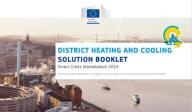Details
- Publication date
- 10 September 2024
- Authors
- European Climate, Infrastructure and Environment Executive Agency | European Commission Library
Description
Half of the energy consumed in Europe is used for heating and cooling, and 75% of this energy is still coming from fossil fuels. Additionally, much of this energy is wasted due to inefficiencies in the heating and cooling systems. State-of-the-art, sustainable district heating and cooling systems offer a unique opportunity to make significant contributions to decarbonise EU cities through the efficient distribution of heat and cold from renewable energy sources.
District heating networks (initially centralised heat production, delivered through distribution networks) have been present in cities for more than one hundred years, evolving from the early high-temperature heat distribution (steam) networks towards more efficient lower temperature schemes that reduce heat distribution losses and enable the use of renewable energy sources, as well as the integration with the electricity grid. Also, current intelligent management systems allow for increased operational benefits and new paradigms such as decentralised networks.
District heating and cooling networks constitute a proven solution for large scale thermal energy distribution that has been deployed in a growing number of cities worldwide, using a diversity of technologies that can enable synergies between the production and distribution of heat, cold, domestic hot water and electricity.
Find the previous version of this booklet here.

